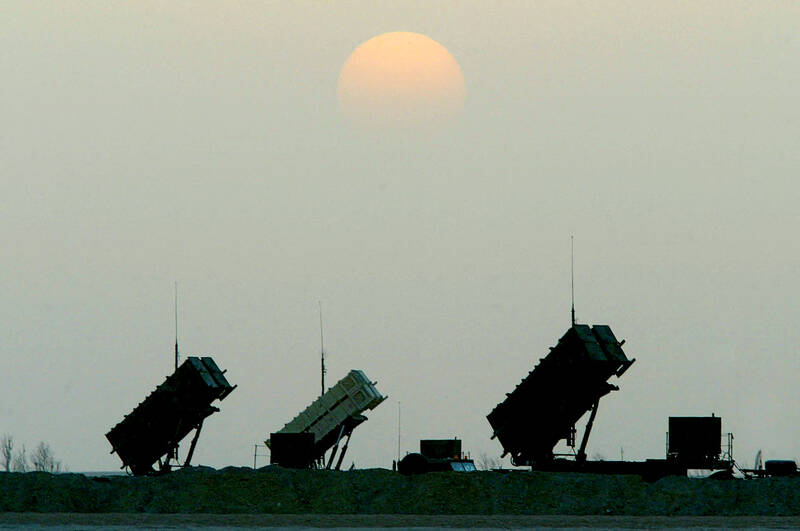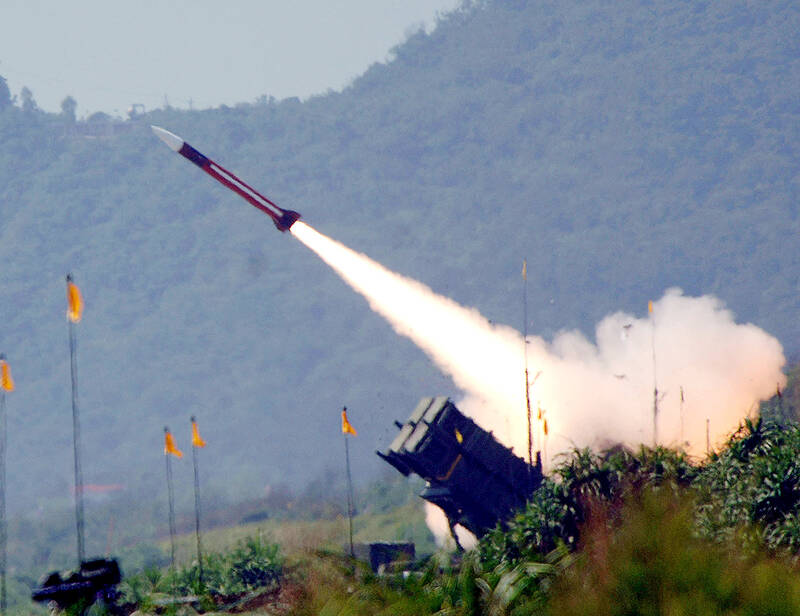Patriot missile systems have long been a hot ticket item for the US and allies in contested areas of the world as a coveted shield against incoming missiles. In Europe, the Middle East and the Pacific, they guard against potential strikes from Iran, Somalia and North Korea.
So it was a critical turning point when news broke this week that the US has agreed to send a Patriot missile battery to Ukraine — something Ukrainian President Volodymyr Zelenskyy has sought for months to augment his country’s air defenses. US officials have confirmed the agreement, and an official announcement is expected soon. But experts caution that the system’s effectiveness is limited, and it may not be a game changer in the war.
A look at what the system is and what it does:

Photo: AFP
WHAT IS THE PATRIOT?
The Patriot is a surface-to-air guided missile system that was first deployed in the 1980s and can target aircraft, cruise missiles and shorter-range ballistic missiles.
Each Patriot battery consists of a truck-mounted launching system with eight launchers that can hold up to four missile interceptors each, a ground radar, a control station and a generator. The Army said it currently has 16 Patriot battalions. A 2018 International Institute for Strategic Studies report found those battalions operate 50 batteries, which have more than 1,200 missile interceptors.

Photo: AFP
The US batteries are regularly deployed around the world. In addition, Patriots also are operated or being purchased by the Netherlands, Germany, Japan, Israel, Saudi Arabia, Kuwait, Taiwan, Greece, Spain, South Korea, the United Arab Emirates, Qatar, Romania, Sweden, Poland and Bahrain.
The Patriot system “is one of the most widely operated and reliable and proven air missile defense systems out there,” and the theater ballistic missile defense capability could help defend Ukraine against Iranian-supplied ballistic missiles, said Tom Karako, director of the Missile Defense Project at the Center for Strategic and International Studies.
PATRIOT COST
Over the years the Patriot system and missiles have been continually modified. The current interceptor missile for the Patriot system costs approximately US$4 million per round and the launchers cost about US$10 million each, CSIS reported in its July missile defense report. At that price, it’s not cost effective or optimal to use the Patriot to shoot down the far smaller and dramatically cheaper Iranian drones that Russia has been buying and using in Ukraine.
“Firing a million-dollar missile at a US$50,000 drone is a losing proposition,” said Mark Cancian, a retired Marine Corps reserves colonel and senior adviser at CSIS.
DEPLOYMENT CONCERNS
A Patriot battery can need as many as 90 troops to operate and maintain it, and for months the US was reluctant to provide the complex system because sending forces into Ukraine to operate it is a non-starter for the Biden administration.
But there were also concerns that deployment of the system would provoke Russia, or risk that a missile fired could end up hitting inside Russia, which could further escalate the conflict.
On Thursday, Russia’s Foreign Ministry warned that a US plan to deliver sophisticated air defense missiles to Ukraine would be “another provocative move by the US” that could prompt a response from Moscow.
According to officials, the urgent pleadings of Ukrainian leaders and the devastating destruction of the country’s civilian infrastructure, including loss of electricity and heat as winter drags on, ultimately overcame US reservations about supplying the Patriots.
A key hurdle will be training. US troops will have to train Ukrainian forces on how to use and maintain the system. Army solders assigned to Patriot battalions get extensive training to be able to effectively locate a target, lock on with radar and fire.
The US has trained Ukrainian troops on other complex weapons systems, including the High Mobility Artillery Rocket Systems, known as HIMARS. In many cases they’ve been able to shorten the training, getting Ukrainian troops out to the battlefront in weeks. Officials have declined to provide details on how long the Patriots training would take and where exactly it will be done.
PATRIOT CAPABILITIES
Ukraine faces a range of Russian threats, and the Patriot is good against some and not that useful against others.
One former senior military official with knowledge of the Patriot system said it will be effective against short-range ballistic missiles and it represents a strong message of US support, but one battery isn’t going to change the course of the war.
The official, who spoke on condition of anonymity because the Ukraine deal has not yet been made public, noted that one Patriot battery has a long firing range, but can cover only a limited broad area. As an example, Patriots can effectively protect a small military base, but can’t fully protect a large city such as Kyiv. They could only provide coverage for a segment of a city.
Patriots are often deployed as a battalion, which includes four batteries. This won’t be the case with Ukraine, which officials said would be receiving one battery.
The Patriot has a more powerful radar that is better at discriminating targets than the Soviet-era S-300 system the Ukrainians have been using, but it has limitations, both Karako and Cancian said.
Still the Patriot’s ability to target some ballistic missiles and aircraft could potentially protect Kyiv if Russian President Vladimir Putin carried through on his persistent threat to deploy a tactical nuclear device. But that would depend on how the weapon was delivered, Karako said. If it was a gravity bomb delivered by a warplane, the system could target the aircraft; if it was a cruise or short-to-medium-range ballistic missile, it could also possibly intercept the missile, Karako said.
Raytheon, which manufactures the Patriot, says it has been involved in 150 intercepts of ballistic missiles since 2015. The success rate of the Patriot, however, has been repeatedly questioned. A 1992 Government Accountability Office report said it could not find evidence to support reports that the system had achieved a 70 percent success rate against Scud missiles in the Gulf War. In 2018, Saudi Arabia’s success in using Patriots against missiles fired by Houthi rebels in Yemen was questioned when videos surfaced of systems failing.
But beyond the Patriot’s capabilities, its deployment is a big statement of support for Ukraine.
“There’s a lot of symbolism here,” Cancian said.
Note to readers:The View from Central Taiwan will return to these pages on Monday next week.

As I finally slid into the warm embrace of the hot, clifftop pool, it was a serene moment of reflection. The sound of the river reflected off the cave walls, the white of our camping lights reflected off the dark, shimmering surface of the water, and I reflected on how fortunate I was to be here. After all, the beautiful walk through narrow canyons that had brought us here had been inaccessible for five years — and will be again soon. The day had started at the Huisun Forest Area (惠蓀林場), at the end of Nantou County Route 80, north and east

Specialty sandwiches loaded with the contents of an entire charcuterie board, overflowing with sauces, creams and all manner of creative add-ons, is perhaps one of the biggest global food trends of this year. From London to New York, lines form down the block for mortadella, burrata, pistachio and more stuffed between slices of fresh sourdough, rye or focaccia. To try the trend in Taipei, Munchies Mafia is for sure the spot — could this be the best sandwich in town? Carlos from Spain and Sergio from Mexico opened this spot just seven months ago. The two met working in the

Exceptions to the rule are sometimes revealing. For a brief few years, there was an emerging ideological split between the Democratic Progressive Party (DPP) and Chinese Nationalist Party (KMT) that appeared to be pushing the DPP in a direction that would be considered more liberal, and the KMT more conservative. In the previous column, “The KMT-DPP’s bureaucrat-led developmental state” (Dec. 11, page 12), we examined how Taiwan’s democratic system developed, and how both the two main parties largely accepted a similar consensus on how Taiwan should be run domestically and did not split along the left-right lines more familiar in

A six-episode, behind-the-scenes Disney+ docuseries about Taylor Swift’s Eras Tour and Rian Johnson’s third Knives Out movie, Wake Up Dead Man, are some of the new television, films, music and games headed to a device near you. Also among the streaming offerings worth your time this week: Chip and Joanna Gaines take on a big job revamping a small home in the mountains of Colorado, video gamers can skateboard through hell in Sam Eng’s Skate Story and Rob Reiner gets the band back together for Spinal Tap II: The End Continues. MOVIES ■ Rian Johnson’s third Knives Out movie, Wake Up Dead Man